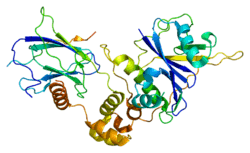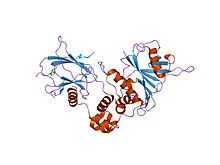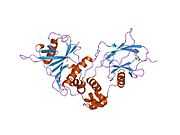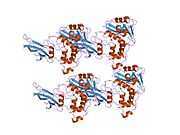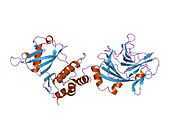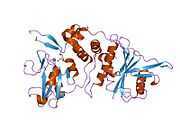TCEB2
Transcription elongation factor B polypeptide 2 is a protein that in humans is encoded by the TCEB2 gene.[1]
Function
This gene encodes the protein elongin B, which is a subunit of the transcription factor B (SIII) complex. The SIII complex is composed of elongins A/A2, B and C. It activates elongation by RNA polymerase II by suppressing transient pausing of the polymerase at many sites within transcription units. Elongin A functions as the transcriptionally active component of the SIII complex, whereas elongins B and C are regulatory subunits. Elongin A2 is specifically expressed in the testis, and capable of forming a stable complex with elongins B and C. The von Hippel-Lindau tumor suppressor protein binds to elongins B and C, and thereby inhibits transcription elongation. Two alternatively spliced transcript variants encoding different isoforms have been described for this gene.[2]
Interactions
TCEB2 has been shown to interact with:
References
- ↑ Garrett KP, Aso T, Bradsher JN, Foundling SI, Lane WS, Conaway RC et al. (September 1995). "Positive regulation of general transcription factor SIII by a tailed ubiquitin homolog". Proc Natl Acad Sci U S A 92 (16): 7172–6. doi:10.1073/pnas.92.16.7172. PMC 41301. PMID 7638163.
- ↑ "Entrez Gene: TCEB2 transcription elongation factor B (SIII), polypeptide 2 (18kDa, elongin B)".
- ↑ 3.0 3.1 Menon S, Tsuge T, Dohmae N, Takio K, Wei N. "Association of SAP130/SF3b-3 with Cullin-RING ubiquitin ligase complexes and its regulation by the COP9 signalosome". BMC Biochem. 9: 1. doi:10.1186/1471-2091-9-1. PMC 2265268. PMID 18173839.
- ↑ Kamura T, Burian D, Yan Q, Schmidt SL, Lane WS, Querido E et al. (August 2001). "Muf1, a novel Elongin BC-interacting leucine-rich repeat protein that can assemble with Cul5 and Rbx1 to reconstitute a ubiquitin ligase". J. Biol. Chem. 276 (32): 29748–53. doi:10.1074/jbc.M103093200. PMID 11384984.
- ↑ Rual JF, Venkatesan K, Hao T, Hirozane-Kishikawa T, Dricot A, Li N et al. (October 2005). "Towards a proteome-scale map of the human protein-protein interaction network". Nature 437 (7062): 1173–8. doi:10.1038/nature04209. PMID 16189514.
- ↑ 6.0 6.1 Ohh M, Takagi Y, Aso T, Stebbins CE, Pavletich NP, Zbar B et al. (Dec 1999). "Synthetic peptides define critical contacts between elongin C, elongin B, and the von Hippel-Lindau protein". J. Clin. Invest. 104 (11): 1583–91. doi:10.1172/JCI8161. PMC 481054. PMID 10587522.
- ↑ Krumm A, Groudine M (September 1995). "Tumor suppression and transcription elongation: the dire consequences of changing partners". Science 269 (5229): 1400–1. doi:10.1126/science.7660121. PMID 7660121.
- ↑ Li Z, Na X, Wang D, Schoen SR, Messing EM, Wu G (February 2002). "Ubiquitination of a novel deubiquitinating enzyme requires direct binding to von Hippel-Lindau tumor suppressor protein". J. Biol. Chem. 277 (7): 4656–62. doi:10.1074/jbc.M108269200. PMID 11739384.
- ↑ Ewing RM, Chu P, Elisma F, Li H, Taylor P, Climie S et al. "Large-scale mapping of human protein-protein interactions by mass spectrometry". Mol. Syst. Biol. 3: 89. doi:10.1038/msb4100134. PMC 1847948. PMID 17353931.
- ↑ Min JH, Yang H, Ivan M, Gertler F, Kaelin WG, Pavletich NP (June 2002). "Structure of an HIF-1alpha -pVHL complex: hydroxyproline recognition in signaling". Science 296 (5574): 1886–9. doi:10.1126/science.1073440. PMID 12004076.
- ↑ Hacker KE, Lee CM, Rathmell WK. Zhang B, ed. "VHL type 2B mutations retain VBC complex form and function". PLoS ONE 3 (11): e3801. doi:10.1371/journal.pone.0003801. PMC 2583047. PMID 19030229.
Further reading
- Duan DR, Pause A, Burgess WH, Aso T, Chen DY, Garrett KP et al. (1995). "Inhibition of transcription elongation by the VHL tumor suppressor protein". Science 269 (5229): 1402–6. doi:10.1126/science.7660122. PMID 7660122.
- Aso T, Lane WS, Conaway JW, Conaway RC (1995). "Elongin (SIII): a multisubunit regulator of elongation by RNA polymerase II". Science 269 (5229): 1439–43. doi:10.1126/science.7660129. PMID 7660129.
- Kibel A, Iliopoulos O, DeCaprio JA, Kaelin WG (1995). "Binding of the von Hippel-Lindau tumor suppressor protein to Elongin B and C". Science 269 (5229): 1444–6. doi:10.1126/science.7660130. PMID 7660130.
- Bradsher JN, Jackson KW, Conaway RC, Conaway JW (1994). "RNA polymerase II transcription factor SIII. I. Identification, purification, and properties". J. Biol. Chem. 268 (34): 25587–93. PMID 8244996.
- Pause A, Lee S, Worrell RA, Chen DY, Burgess WH, Linehan WM et al. (1997). "The von Hippel-Lindau tumor-suppressor gene product forms a stable complex with human CUL-2, a member of the Cdc53 family of proteins". Proc. Natl. Acad. Sci. U.S.A. 94 (6): 2156–61. doi:10.1073/pnas.94.6.2156. PMC 20057. PMID 9122164.
- Li XY, Green MR (1998). "The HIV-1 Tat cellular coactivator Tat-SF1 is a general transcription elongation factor". Genes Dev. 12 (19): 2992–6. doi:10.1101/gad.12.19.2992. PMC 317190. PMID 9765201.
- Zhang JG, Farley A, Nicholson SE, Willson TA, Zugaro LM, Simpson RJ et al. (1999). "The conserved SOCS box motif in suppressors of cytokine signaling binds to elongins B and C and may couple bound proteins to proteasomal degradation". Proc. Natl. Acad. Sci. U.S.A. 96 (5): 2071–6. doi:10.1073/pnas.96.5.2071. PMC 26738. PMID 10051596.
- Stebbins CE, Kaelin WG, Pavletich NP (1999). "Structure of the VHL-ElonginC-ElonginB complex: implications for VHL tumor suppressor function". Science 284 (5413): 455–61. doi:10.1126/science.284.5413.455. PMID 10205047.
- Pause A, Peterson B, Schaffar G, Stearman R, Klausner RD (1999). "Studying interactions of four proteins in the yeast two-hybrid system: structural resemblance of the pVHL/elongin BC/hCUL-2 complex with the ubiquitin ligase complex SKP1/cullin/F-box protein". Proc. Natl. Acad. Sci. U.S.A. 96 (17): 9533–8. doi:10.1073/pnas.96.17.9533. PMC 22243. PMID 10449727.
- Iwai K, Yamanaka K, Kamura T, Minato N, Conaway RC, Conaway JW et al. (1999). "Identification of the von Hippel-lindau tumor-suppressor protein as part of an active E3 ubiquitin ligase complex". Proc. Natl. Acad. Sci. U.S.A. 96 (22): 12436–41. doi:10.1073/pnas.96.22.12436. PMC 22941. PMID 10535940.
- Ohh M, Takagi Y, Aso T, Stebbins CE, Pavletich NP, Zbar B et al. (2000). "Synthetic peptides define critical contacts between elongin C, elongin B, and the von Hippel-Lindau protein". J. Clin. Invest. 104 (11): 1583–91. doi:10.1172/JCI8161. PMC 481054. PMID 10587522.
- Aso T, Yamazaki K, Amimoto K, Kuroiwa A, Higashi H, Matsuda Y et al. (2000). "Identification and characterization of Elongin A2, a new member of the Elongin family of transcription elongation factors, specifically expressed in the testis". J. Biol. Chem. 275 (9): 6546–52. doi:10.1074/jbc.275.9.6546. PMID 10692460.
- Kamura T, Sato S, Iwai K, Czyzyk-Krzeska M, Conaway RC, Conaway JW (2000). "Activation of HIF1alpha ubiquitination by a reconstituted von Hippel-Lindau (VHL) tumor suppressor complex". Proc. Natl. Acad. Sci. U.S.A. 97 (19): 10430–5. doi:10.1073/pnas.190332597. PMC 27041. PMID 10973499.
- Aso T, Yamazaki K, Aigaki T, Kitajima S (2000). "Drosophila von Hippel-Lindau tumor suppressor complex possesses E3 ubiquitin ligase activity". Biochem. Biophys. Res. Commun. 276 (1): 355–61. doi:10.1006/bbrc.2000.3451. PMID 11006129.
- Kamura T, Burian D, Yan Q, Schmidt SL, Lane WS, Querido E et al. (2001). "Muf1, a novel Elongin BC-interacting leucine-rich repeat protein that can assemble with Cul5 and Rbx1 to reconstitute a ubiquitin ligase". J. Biol. Chem. 276 (32): 29748–53. doi:10.1074/jbc.M103093200. PMID 11384984.
- Li Z, Na X, Wang D, Schoen SR, Messing EM, Wu G (2002). "Ubiquitination of a novel deubiquitinating enzyme requires direct binding to von Hippel-Lindau tumor suppressor protein". J. Biol. Chem. 277 (7): 4656–62. doi:10.1074/jbc.M108269200. PMID 11739384.
- Yamazaki K, Guo L, Sugahara K, Zhang C, Enzan H, Nakabeppu Y et al. (2002). "Identification and biochemical characterization of a novel transcription elongation factor, Elongin A3". J. Biol. Chem. 277 (29): 26444–51. doi:10.1074/jbc.M202859200. PMID 11994304.
- Min JH, Yang H, Ivan M, Gertler F, Kaelin WG, Pavletich NP (2002). "Structure of an HIF-1alpha -pVHL complex: hydroxyproline recognition in signaling". Science 296 (5574): 1886–9. doi:10.1126/science.1073440. PMID 12004076.
- Hon WC, Wilson MI, Harlos K, Claridge TD, Schofield CJ, Pugh CW et al. (2002). "Structural basis for the recognition of hydroxyproline in HIF-1 alpha by pVHL". Nature 417 (6892): 975–8. doi:10.1038/nature00767. PMID 12050673.
| |||||||||||||||||||
